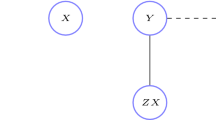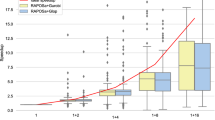Abstract
We provide a sparse version of the bounded degree SOS hierarchy BSOS (Lasserre et al. in EURO J Comp Optim:87–117, 2017) for polynomial optimization problems. It permits to treat large scale problems which satisfy a structured sparsity pattern. When the sparsity pattern satisfies the running intersection property this Sparse-BSOS hierarchy of semidefinite programs (with semidefinite constraints of fixed size) converges to the global optimum of the original problem. Moreover, for the class of SOS-convex problems, finite convergence takes place at the first step of the hierarchy, just as in the dense version.
Similar content being viewed by others
Notes
Recently Marandi et al. [14] have shown that BSOS provides better bounds than the first relaxation of PUT for the Pooling Problem—another instance of quadratic/quadratically constrained problems. However their experiments also show that BSOS (i) does not always solve these difficult problems to optimality at a low level “d” relaxation and (ii) does not scale well.
The numerical experiments were run on a standard lap-top from the year 2015. For a more detailed description see page 13.
If in the description (P) some degree “s” is strictly larger than 2 then for Sparse-PUT’s first relaxation, the size of the largest positive semidefinite variable is already at least \(O(\kappa ^{\lceil s/2\rceil })\) where \(\kappa \) is the size of the largest clique in some graph associated with the problem; if \(\kappa \) is not small it can be prohibitive. In contrast, for all the Sparse-BSOS relaxations (with parameter \(k=1\)), this largest size is only \(O(\kappa )\).
In Sparse-PUT the maximum size of the psd variables is \({n^*+d\atopwithdelims ()n^*}\times {n^*+d\atopwithdelims ()d}\) where \(n^*=\max _\ell \vert I_\ell \vert \) and \(2d\ge \max [\mathrm{deg}(f),\mathrm{deg}(g_j)]\).
In this context we consider two numbers to be equal if there difference is less than \(10^{-8}\).
By this we means that a random value between \(-1\) and 1 is assigned to an entry \(a_{ij}\) of A if and only if both i and j are contained in the same \(I_\ell \) for some \(\ell \). Otherwise \(a_{ij}=0\). The values of b are randomly generated between \(-1\) and 1, too.
Also note that Assumption 2 is fulfilled only when \(s=2\). In the case of \(s=1\) with the same arguments as in the first part of the proof of Theorem 3, one can show that in this case with \(d \ge 2\), the feasible set of the SDP (9) is compact and an optimal solution is attained. Furthermore, since the set \({\mathbf {K}}\) is a polyhedron, the quadratic modules associated to the \(K_\ell \) are archimedean. One can adapt the proofs of Theorem 1 and 2 so that the convergence result is still true in the case \(s=1\).
Regarding this example the implementation of equalities using sampling might look questionable. Its positive effect comes into play when considering larger psd variables. In [6] the authors were able to handle problems with psd variables of size up to 861 (\(n=40\), \(k=2\)) due to the special handling of the constraints associated to the psd variable in the case of sampling. This is by far out of the range of what can be done by comparing coefficients.
References
Handelman, D.: Representing polynomials by positive linear functions on compact convex polyhedra. Pac. J. Math. 132, 35–62 (1988)
Henrion, D., Lasserre, J.B., Lofberg, J.: GloptiPoly 3: moments, optimization and semidefinite programming. Optim. Methods Softw. 24, 761–779 (2009)
Josz, C, Molzahn, D.K.: Moment/sum-of-squares hierarchy for complex polynomial optimization. preprint arxiv:1508.02068v2, (2016)
Kojima, M., Muramatsu, M.: A note on sparse sos and sdp relaxations for polynomial optimization problems over symmetric cones. Comput. Optim. Appl. 42, 31–41 (2009)
Krivine, J.L.: Anneaux préordonnés. J. Anal. Math. 12, 307–326 (1964)
Lasserre, J.B., Toh, K.C., Yang, S.: A bounded degree SOS hierarchy for polynomial optimization. EURO J. Comp. Optim. 5, 87–117 (2017)
Lasserre, J.B.: Global optimization with polynomials and the problem of moments. SIAM J. Optim. 11, 796–817 (2001)
Lasserre, J.B.: Semidefinite programming vs. LP relaxations for polynomial programming. Math. Oper. Res. 27, 347–360 (2002)
Lasserre, J.B.: A Lagrangian relaxation view of linear and semidefinite hierarchies. SIAM J. Optim. 23, 1742–1756 (2013)
Lasserre, J.B.: Convergent SDP-relaxations in polynomial optimization with sparsity. SIAM J. Optim. 17, 822–843 (2006)
Lasserre, J.B.: Moments, Positive Polynomials and Their Applications. Imperial College Press, London (2009)
Lasserre, J.B.: An Introduction to Polynomial and Semi-Algebraic Optimization. Cambridge University Press, Cambridge (2015)
Löefberg, J.: YALMIP: A toolbox for modeling and optimization in MATLAB. IEEE CCA/ISIS/CACSD, (2004)
Marandi, A., Dahl, J., de Klerk E.: A numerical evaluation of the bounded degree sum-of-squares hierarchy of Lasserre, Toh, and Yang on the pooling problem. Ann. Oper. Res., 1–26, (2017)
Molzahn, D.K., Hiskens, I.A.: Sparsity-exploiting moment-based relaxations of the optimal power flow problem. IEEE Trans. Power Syst. 30, 3168–3180 (2015)
Molzahn, D.K., Baghsorkhi, S.S., Hiskens, I.A.: Semidefinite relaxations of equivalent optimal power flow problems: an illustrative example. In: IEEE International Symposium on Circuits and Systems (ISCAS), (2015)
MOSEK ApS, The MOSEK optimization toolbox for MATLAB manual, (2015)
Putinar, M.: Positive polynomials on compact semi-algebraic sets. Ind. Univ. Math. J. 42, 969–984 (1993)
Stengle, G.: A Nullstellensatz and a Positivstellensatz in semialgebraic geometry. Math. Ann. 207, 87–97 (1974)
Sturm, J.F.: Using SeDuMi 1.02, a MATLAB toolbox for optimization over symmetric cones. Optim. Methods Softw. 11–12, 625–653 (1999)
Toh, K.C., Todd, M.J., Tutuncu, R.H.: SDPT3—a Matlab software package for semidefinite programming. Optim. Methods Softw. 11, 545–581 (1999)
Toh, K.C., Todd, M.J., Tutuncu, R.H.: Solving semidefinite-quadratic-linear programs using SDPT3. Math. Program. 95, 189–217 (2003)
Vasilescu, F.-H.: Spectral Measures and Moment Problems, in Spectral Theory and Its Applications. Theta Foundation, Bucharest (2003)
Waki, S., Kim, S., Kojima, M., Maramatsu, M.: Sums of squares and semidefinite programming relaxations for polynomial optimization problems with structured sparsity. SIAM J. Optim. 17, 218–242 (2006)
Acknowledgements
The first author is very thankful to the National University of Singapore and Professor Kim-Chuan Toh for their hospitality and financial support during his stay in Singapore.
Author information
Authors and Affiliations
Corresponding author
Additional information
The work of T. Weisser is partially supported by a PGMO Grant from Fondation Mathématique Jacques Hadamard and a Grant from the ERC council for the Taming project (ERC-Advanced Grant #666981 TAMING.
Rights and permissions
About this article
Cite this article
Weisser, T., Lasserre, J.B. & Toh, KC. Sparse-BSOS: a bounded degree SOS hierarchy for large scale polynomial optimization with sparsity. Math. Prog. Comp. 10, 1–32 (2018). https://doi.org/10.1007/s12532-017-0121-6
Received:
Accepted:
Published:
Issue Date:
DOI: https://doi.org/10.1007/s12532-017-0121-6
Keywords
- Global optimization
- Semidefinite programming
- Sparsity
- Large scale problems
- Convex relaxations
- Positivity certificates




